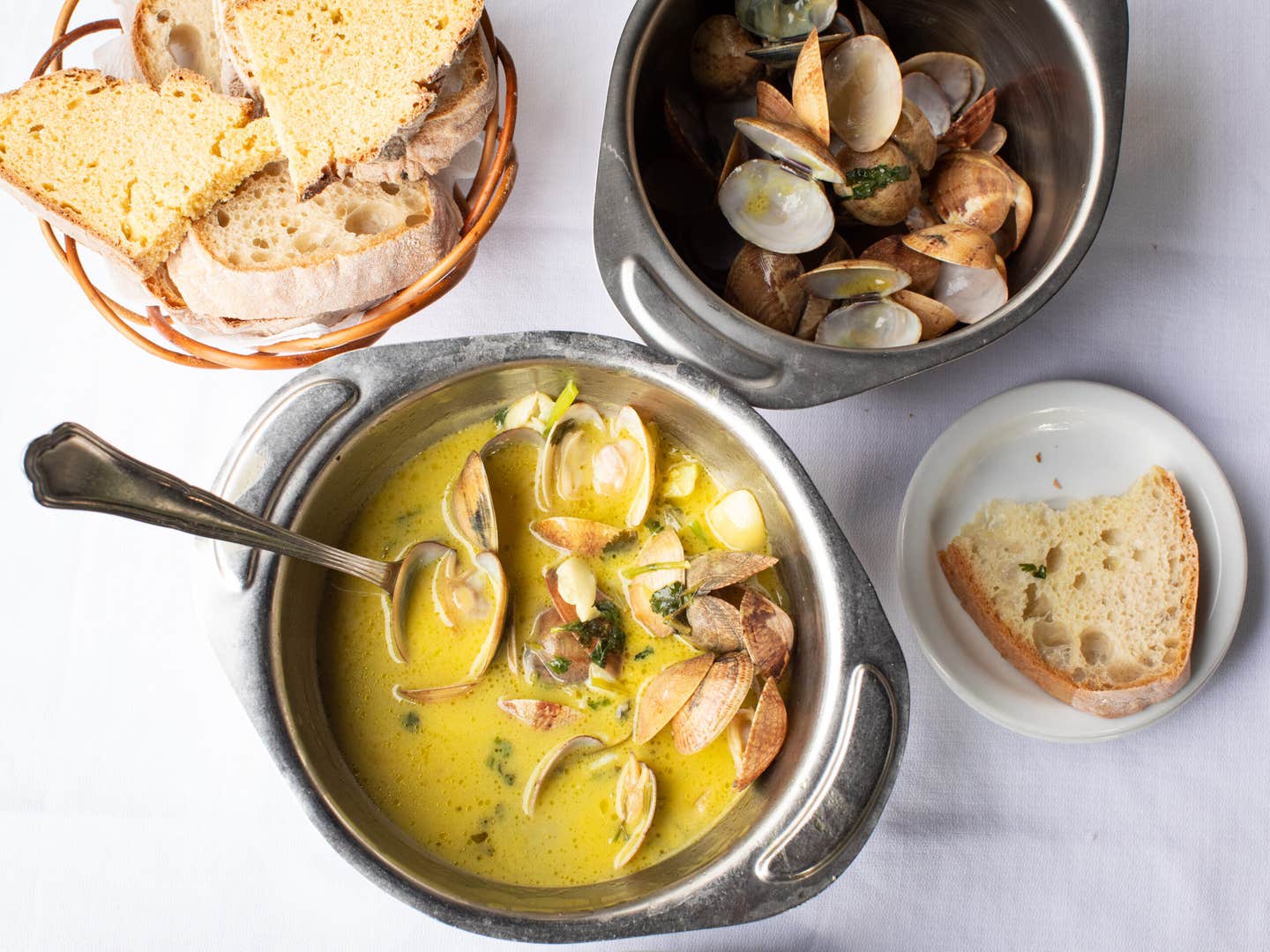
The Top 13 Dishes to Try in Lisbon
Where to find the best cod fritters, custard tarts, piri-piri chicken, and more.
Elemental and unpretentious, Portuguese cooking is born from homes, farms, and fishermen. At its best, it tastes of the sun, olive oil, onions, and ocean. In summer and fall, Lisbon’s markets brim with figs that taste of honey and peaches dense with juice. In winter, downtown praças smell of roasting chestnuts. And in June, sardines sizzle along narrow streets to honor Lisbon's patron saint, António.
Chances are, you (or someone you know) has visited Lisbon in recent years. Unprecedented numbers have descended on the capital city in the last decade—and, like the architecture and demographics, the food scene is shifting. The delicious silver lining: A cohort of young chefs has emerged, determined to protect the recipes they grew up eating while also pushing things forward—seemingly enjoying the ride. Their food, better than any of the “new” cooking I sampled while living in Lisbon as a pastry chef 15 years ago, is expressive, compelling, and singular.
My guide to Lisbon—my mother’s hometown and a city I’ve returned to all my life—includes the standbys that (blessedly) remain intact today, plus new spots exemplifying the changes afoot. The list runs from day to night to show how Portuguese eat and live. If it’s possible to understand a country by peering through a kitchen door, then I hope with this list of restaurants and dishes you’ll recognize the heart of Lisbon—one devoted to family, tradition, beauty, and impractically long gatherings. Wherever you find yourself, I suggest ordering too many dishes—grilled squid, head-on shrimp, stinky cheese, soupy rice … Then laze onward. Time moves more slowly here, and this potent food is for savoring.
Torrada at Pastelaria Versailles
Avenida da República 15A,
+351 21 354 6340
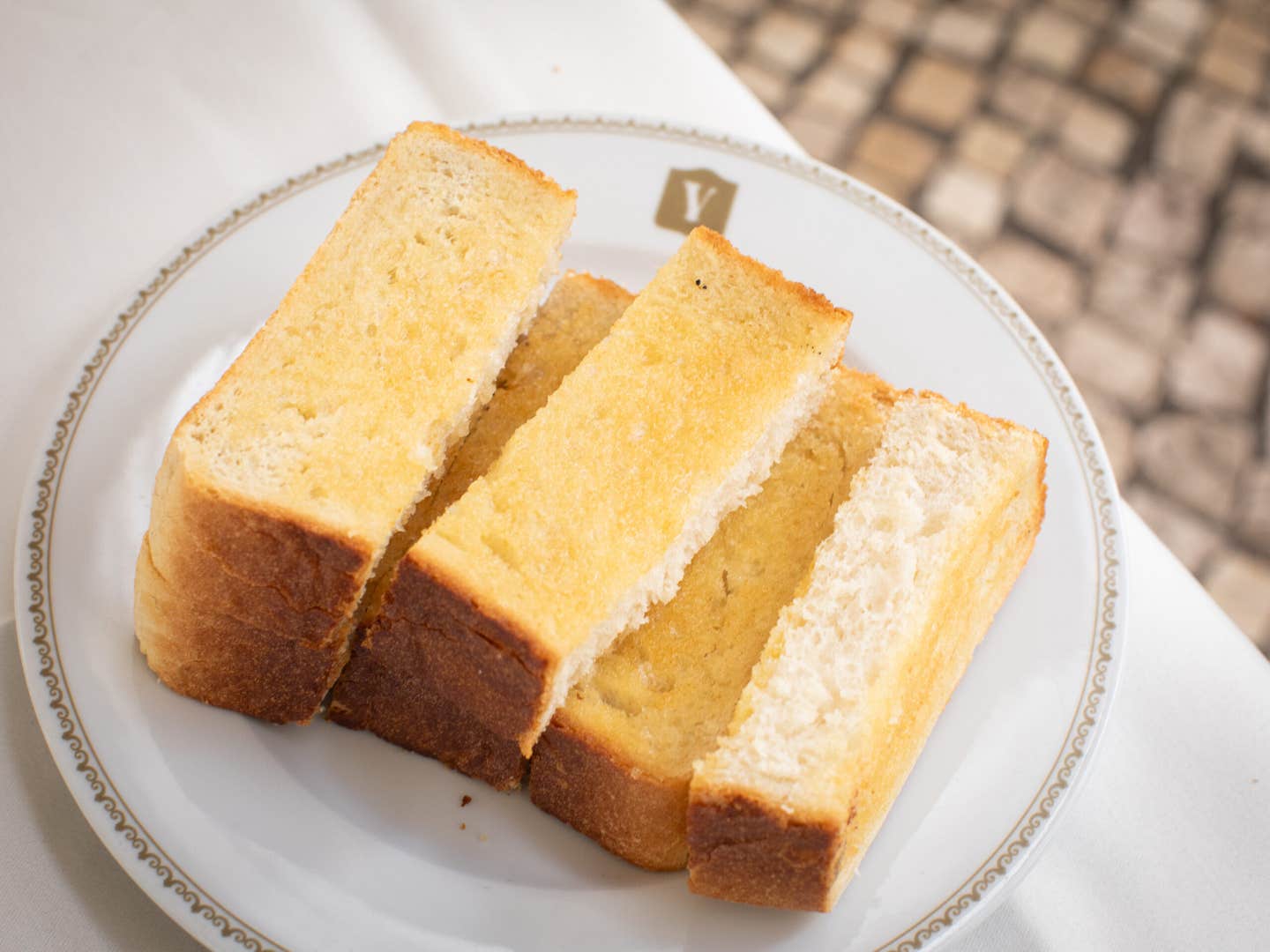
Lisboetas begin their mornings at cafes, either standing at the bar with inky espressos or sitting with a pastry and meia de leite (espresso with warm milk) or galão (diluted with even more milk). While most cafes share a similar menu, they’re not all created equal. Pastelaria Versailles, a gilded art deco building with soaring ceilings, stands out.
Since 1922, men in bowties have served pastries to ladies who lunch (hair curled, pearls affixed, sensible heels secured) at this Lisbon institution whose doors open at 7:30 in the morning and close at 11 p.m. If you’re in the neighborhood at breakfast hour (which in Lisbon bleeds into lunch), I suggest starting the day with a meia de leite and freshly squeezed orange juice (never skimp on OJ in Portugal; the oranges are sublime). Both will complement the main reason for your visit: a torrada.
Toast on steroids, torradas are dense, thick slabs of golden white bread slathered on both sides with salty butter. Each piece stands about an inch and a quarter tall, and an order typically includes two slices, with each cut into thirds. Manners are big in Portugal, so the batons make for delicate eating. (Your lips will glisten with butter, regardless.)
Empadas at Quiosque Príncipe Real
Praça do Príncipe Real 19,
+351 21 805 5266
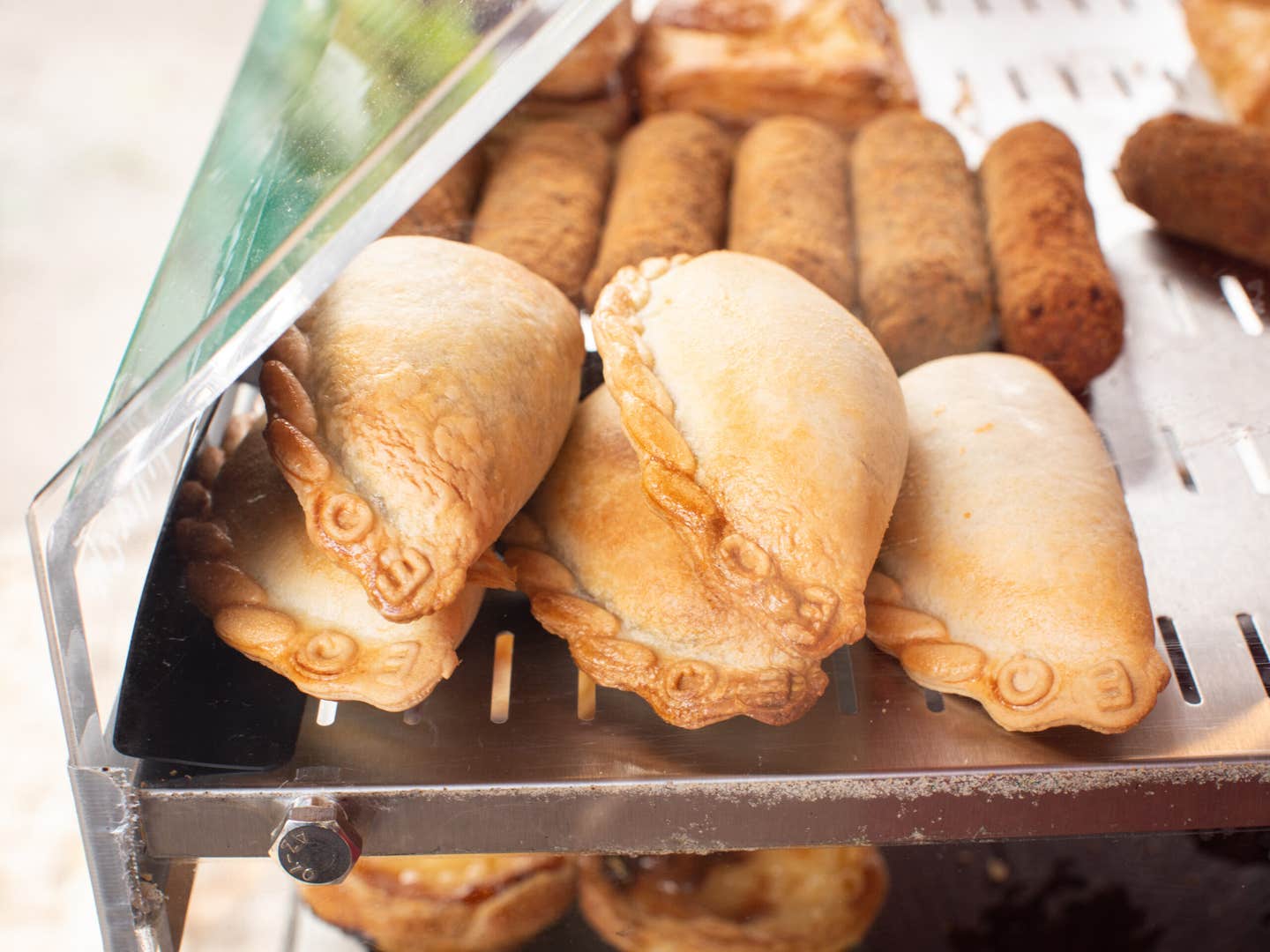
Empadas are darling miniature meat pies that fit in the palm of your hand and are crimped at the edges. They’re made with a buttery dough that, in our home, was cooked before being rolled thin and pressed into small metal tins. Its savory filling, often stewed chicken with perhaps some carrots and peas, got topped with a lid of dough and pinched shut at the edges. An egg wash ensured each one turned a lacquered, nut brown in the oven. Though chicken empanadas are still my favorite, the spinach-stuffed ones are also satisfying when enriched with requeijão, a fresh, milky cheese.
Whenever I’m in Lisbon, I return to the Quiosque in Príncipe Real for a reliable fix (they’re too labor intensive to make solo). This is not a restaurant, rather a stand at the edge of Principe Real park that looks like an information booth. And it punches above its weight in the empada department. I like sitting at one of its sun-soaked tables amid the passing shoppers (on Saturdays, there’s an organic farmers market in the square).
Beef Croquettes at Gambrinus
Rua das Portas de Santo Antão 23,
+351 21 342 1466
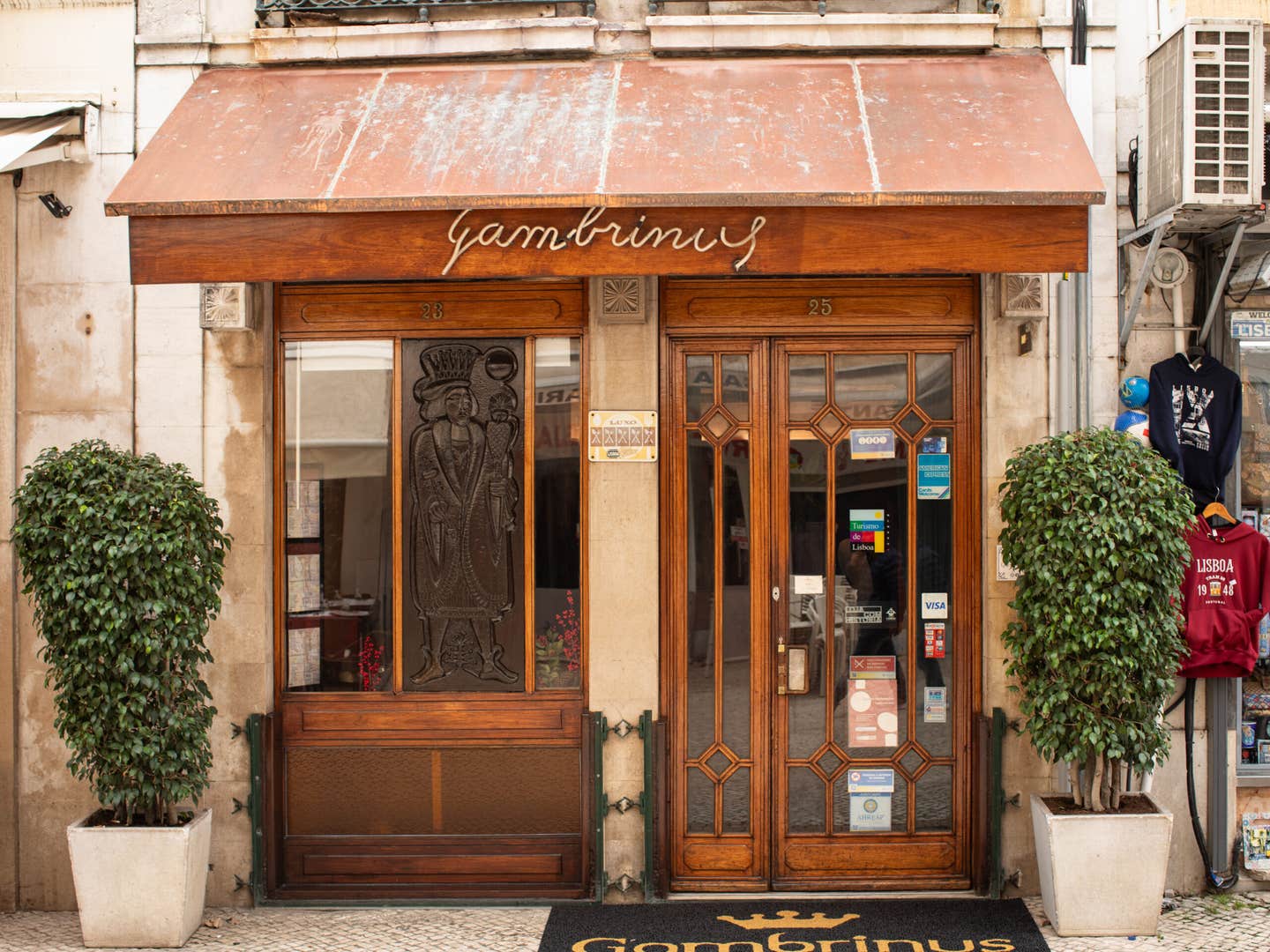
It’s surprising that croquettes aren’t Portugal’s greatest culinary export. These beefy, log-shaped fried morsels are consumed in three to five bites depending on your enthusiasm, and they’re the ultimate beer snack (and kids’ finger food). Made with a mix of braised beef and pork (heavy on the former, lighter on the latter), the filling gets ground up like sausage meat and softened with a touch of bechamel, just enough to make it fudgy (think rillettes but leaner and less livery). The croquettes are then shaped, lightly breaded, and fried to a crisp.
The best ones are fried on the spot and served hot, the breading so crisp it lets off a puff of steam—part of the appeal. That’s how they come at Gambrinus. Frozen in time, this beloved restaurant has been around since 1936, and it’s got swagger. The sleek wooden bar, which seats 12, is where I sit. Croquettes come three per order, but if that’s not enough, either get seconds or spring for the garlicky meat sandwich, another house specialty.
Piri-Piri Chicken at A Valenciana
Rua Marquês Fronteira 157/163A,
+351 21 3884926
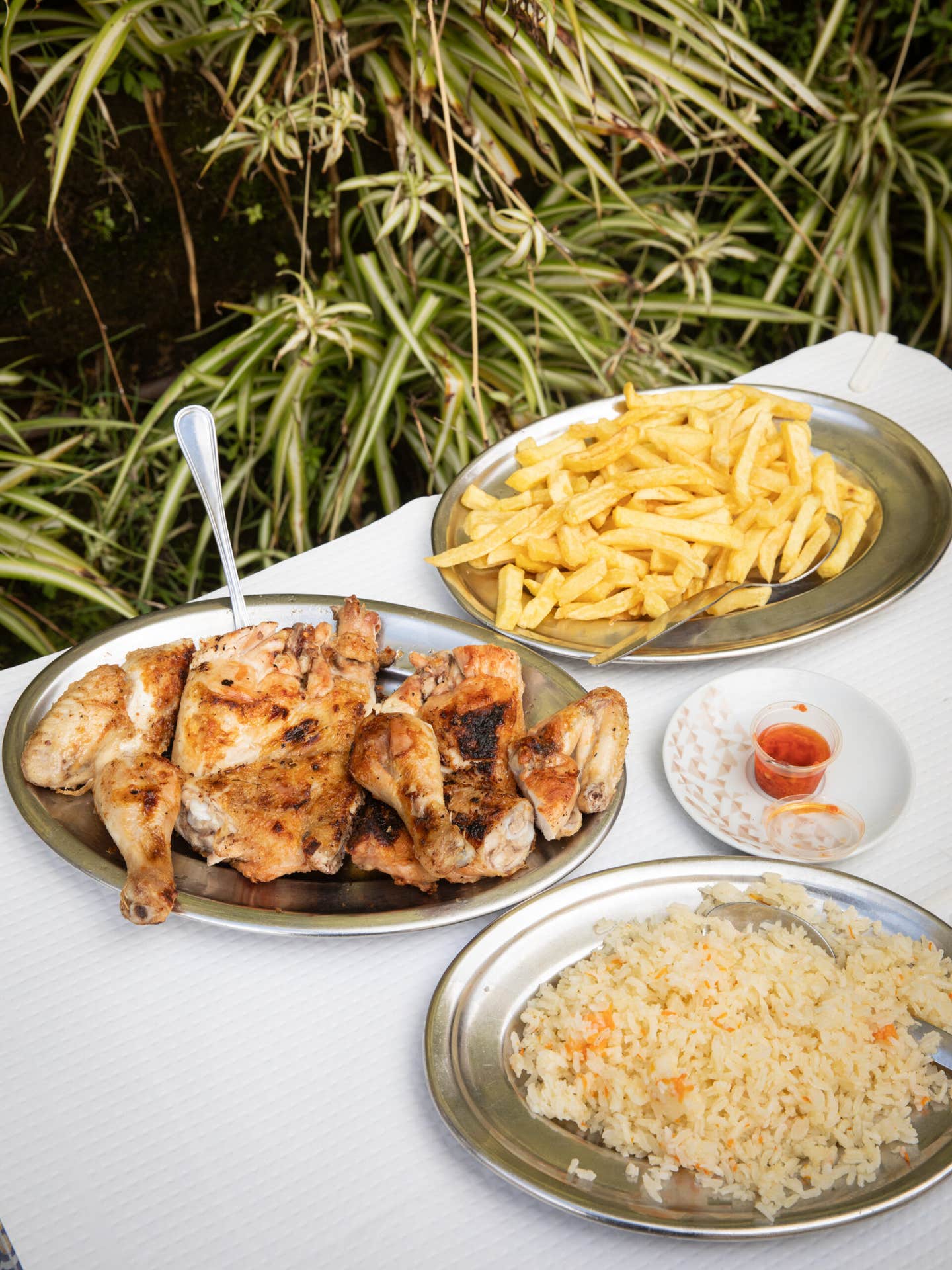
Piri-piri, the name for Portugal’s beloved hot sauce, speaks to the country’s fraught history in Southern Africa, where colonists found bird’s-eye chiles and turned them into a marinade that remains popular today. In Swahili, it’s called peri-peri, meaning “pepper-pepper.” The point, however it’s spelled, is pant-kicking heat. In Portugal, it’s most commonly used as a seasoning that’s basted onto spatchcocked chickens grilled on cast iron grates set over white-hot coals.
Frango piri-piri is sold at small takeaways around Lisbon—there’s usually a massive grill and little else. When you pass such a place (you’ll know because of the fat-laced smoke), be sure to enter and get freshly fried potato chips while you’re at it. But for a sit-down meal, follow locals to the go-to grilled chicken depot: A Valenciana.
Located near the Gulbenkian Foundation (also worth a visit), A Valenciana serves hacked-up whole grilled birds that are all about intense smoky flavor, crackly skin, and succulent meat. Orders come with rice, fries (in Portugal, one carb is never enough), and salad. You’ll quickly appreciate why this dining room, with its poor lighting and unencumbered din, attracts hordes.
Soup at Cantina das Freiras
Travessa do Ferragial 1,
+351 21 324 0910
To understand Portuguese cooking, you must first understand soup. In every Portuguese home I’ve ever visited, soup is served before dinner and, often, at lunch. It’s how children get their vegetables, colds are cured, and stomachs are soothed. Salads, as Americans conceive of them, aren’t really a thing in Portugal. Soup is essential.
While the most famous Portuguese soup is caldo verde, a potato and onion purée brimming with shredded collard greens and chorizo rounds, the most ubiquitous (and, for my money, comforting) is sopa de legumes. These are comforting veloutés that take no cream. Rather, vegetables (whatever is on hand) simmer until soft with a split onion and, frequently, a potato for creaminess. An immersion blender purées the pot until smooth and voluptuous. I love how light and nourishing these are, tasting of fresh vegetables that grow so easily in Portugal. Sopa de legumes is essentially a fridge-sweep soup that always features carrots, potatoes, onions, and a good slip of olive oil. It is pumpkin-colored and soft. When suffused with wilted greens, it becomes sopa de espinafres (spinach soup); with the addition of chopped green beans, it’s sopa de feijão verde.
At Cantina das Freiras, a self-service canteen on the second floor of an unmarked building in the Baixa, a cozy sopa is almost always on the three-course $7 prix-fixe lunch menu. Tourists have discovered this hideaway, but it’s mostly frequented by Portuguese. Everything is cooked by nuns, with proceeds going to charity.
Salt-Baked Fish at Porto Santa Maria
Estrada do Guincho, Cascais,
+351 21 487 9450
If given a say, my last great meal will resemble what’s on offer at Porto Santa Maria. The main course will be salt-baked fish. To taste it, you must venture an hour out of the city’s center to a beach called Guincho—but it is well worth it. If you surf, spend the day at the beach (it’s a surfer magnet) and eat here after. If you’re visiting Sintra, stop here on the way.
Porto Santa Maria’s salt-baked fish is usually 4 to 6 pounds (the catch varies depending on what’s freshest), and you can often pick out the fish you want from a display. Packed in rock salt, it steam-roasts whole, within the thick shell, cooking gently and evenly thanks to the salt granules’ conduction of heat. In the end, juices concentrate as the flesh turns flaky and sticky-tender.
The serving ceremony demands your full attention: A proud waiter arrives tableside to unearth the fish, using just a spoon and fork to exhume filets without a trace of salt. Simple salads of tomatoes and onions may come with, plus boiled potatoes and greens (with olive oil on the side for drizzling). As your meal begins, a march of little bites will arrive unprompted (these are not free!). They’re all great, but the warm shrimp pastries (Rissóis de Camarão) are incredible. Along with the fish, if you have room or enough dining companions, start with a plate or two of amêijoas (more on them below) and a crock of seafood rice.
Tosta Mista at Indanoite é Uma Criança
Praça das Flores 8,
+351 937 724 384
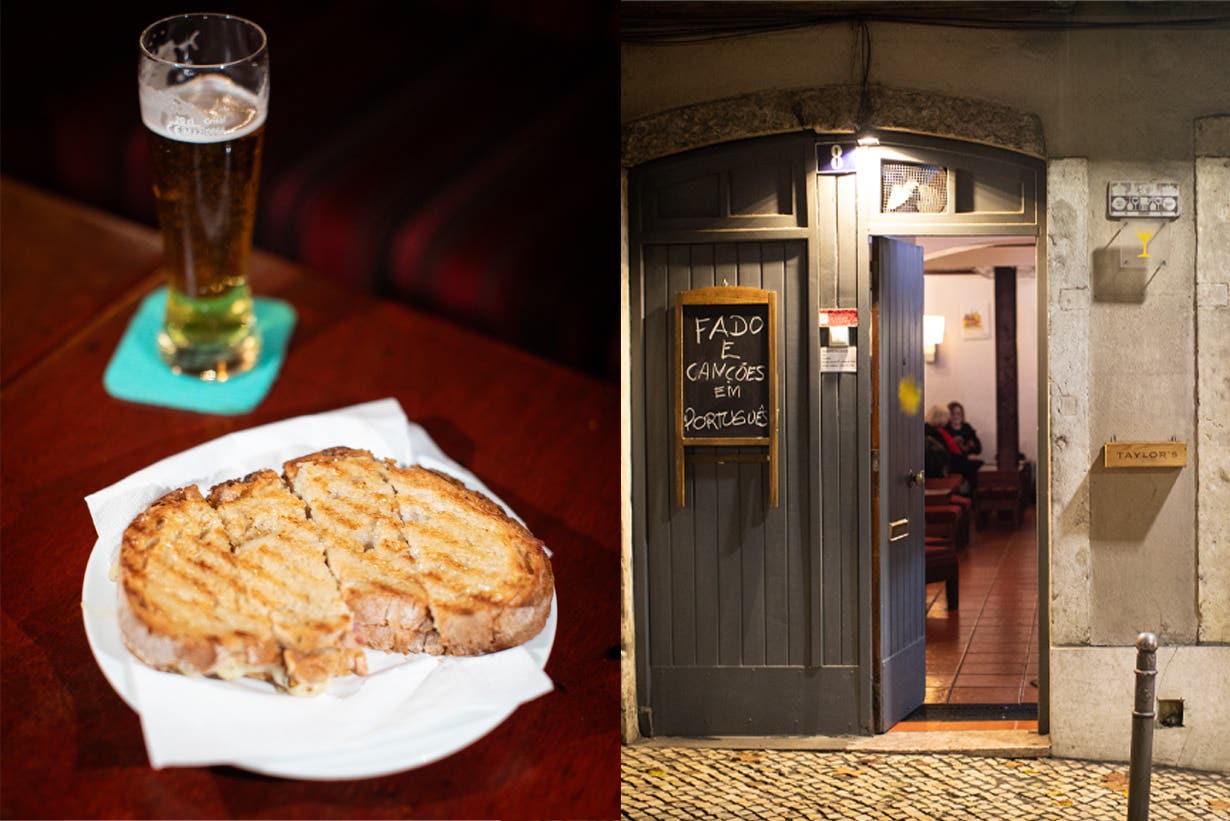
In Lisbon, you can find respectable restaurants open until 4 a.m. or later, but In the wee hours, I want the classic ham and cheese sandwich called tosta mista. It’s warm, oozy, and perfectly buttery at Indanoite é Uma Criança, a night-owl bar where musicians play a mix of fado and Brazilian tunes. The door is unmarked and easily missed, and you must ring to be let in. Inside it feels like a speakeasy crossed with a 1970s living room (cigarette smoke and all). The owner makes each sandwich by hand, adding a dash of oregano—his twist.
Amêijoas à Bulhão Pato at Pinóquio
Praça dos Restauradores 79-80,
+ 351 21 346 5106
Not your American clams, amêijoas are tiny, sweet, and supple. To taste them is to understand the Portuguese palate: heaps of minced garlic sizzle in butter and olive oil. In go the clams, along with a glug of wine and a fistful of cilantro. The seasonings are not discreet—some might say they border on obnoxious—but they produce my favorite dish anywhere, always. Slurping and dunking bread into the drippings is as satisfying as getting a sweet little bit of clam.
In Lisbon, amêijoas à bulhão pato are especially good at cervejarias, large canteens where shellfish, beer, wine, and good eating flow. Ramiro is the most famous, but the less-crammed Pinoquio, located nearby, arguably has superior ameijoas.
Arroz de Coentros at O Pitéu
Largo da Graça 95-96,
+351 21 887 1067
In Graça, just above Alfama near São Jorge Castle, is O Pitéu. In my restaurant days, I’d come here on days off. The steep uphill walk allowed for a feast: Sometimes it was fried fish cakes, other times it was a daily special. But I always made sure to get a pot of arroz de coentros, rice perfumed with cilantro. Presented in a dinked-up pot with a large metal spoon, it’s enough to make a meal of, though it’s only served as an accompaniment.
A word on rice: The Portuguese take it seriously. In Comporta, an hour or so from Lisbon, there’s a museum devoted to it. When it’s soupy, like a thinned out risotto, it signals special occasions. But, unlike in the Italian dish, this rice is long grain, resulting in a less gloopy and starchy texture. Olive oil is the fat of choice, and cheese is never considered.
Pastéis de Bacalhau at Pica-Pau
Rua da Escola Politécnica 27,
+351 21 269 8509
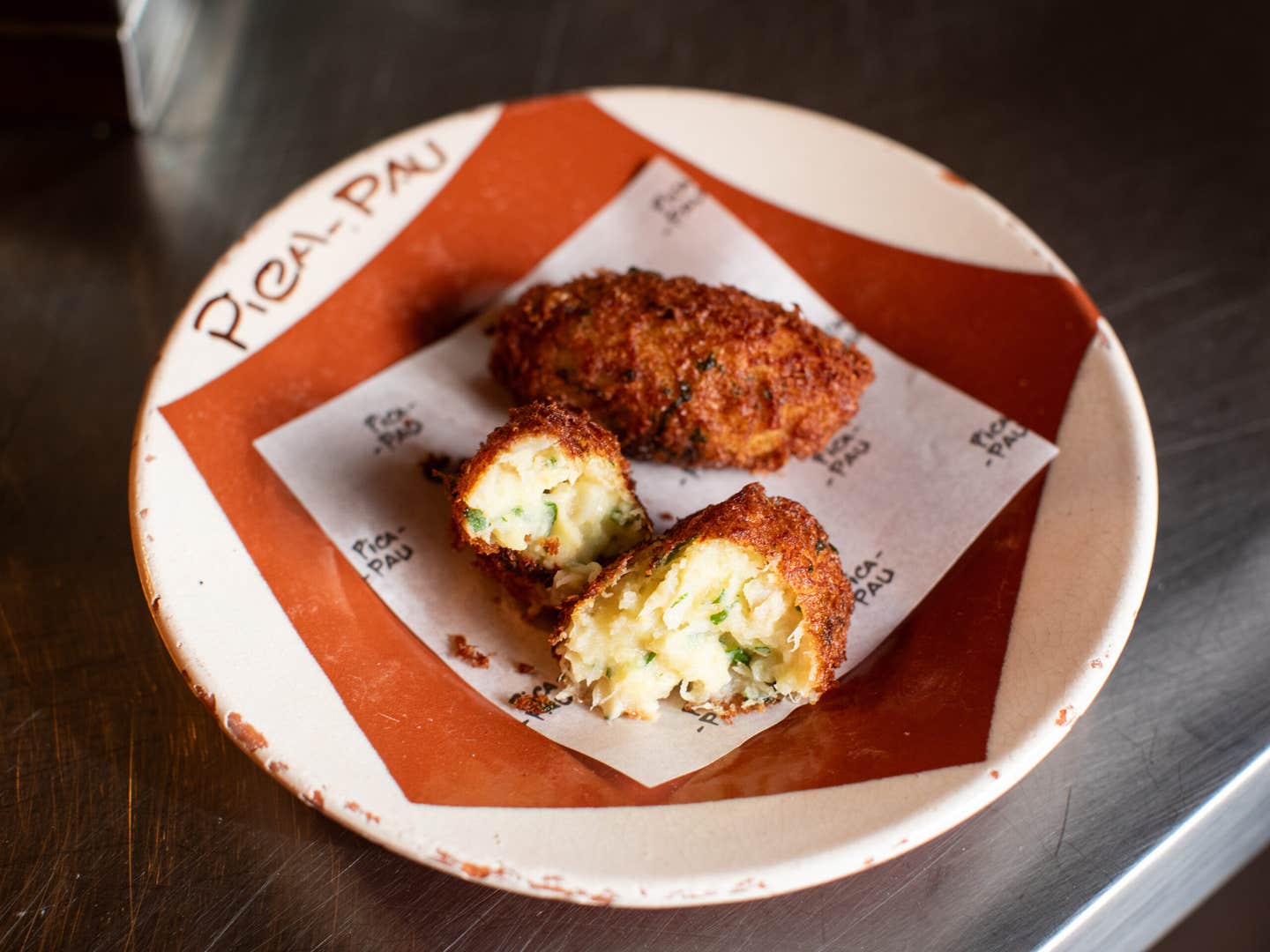
Salt cod is king in Portugal, which is odd for a country with 1,100 miles of coastline and abundant fisheries. Still, it’s as prized today as it was during the age of discovery, when slabs crossed the Atlantic to feed a ship’s crew amid open waters.
There are countless salt cod dishes in Portugal, but my favorite is pastéis de bacalhau, hot fried quenelles of cod and riced potato. To make them, cod is soaked to dislodge its salt cure. Once boiled until easily shredded, it is mixed with the warm potato, plus some parsley, and shaped into tapered cylinders to fry in olive oil (no flour dusting nor breadcrumb coat).
At Pica-Pau, the seasoning—parsley, sauteed onions, a bit of garlic—hits all the right notes, tempering but not overshadowing the cod. Unlike other places that skimp on fish and load up on starch, here everything seems to be made with the young chef’s ancestors’ approval. There is cod aplenty.
Picanha at A Picanha
Rua das Janelas Verdes 96,
+351 21 390 2200
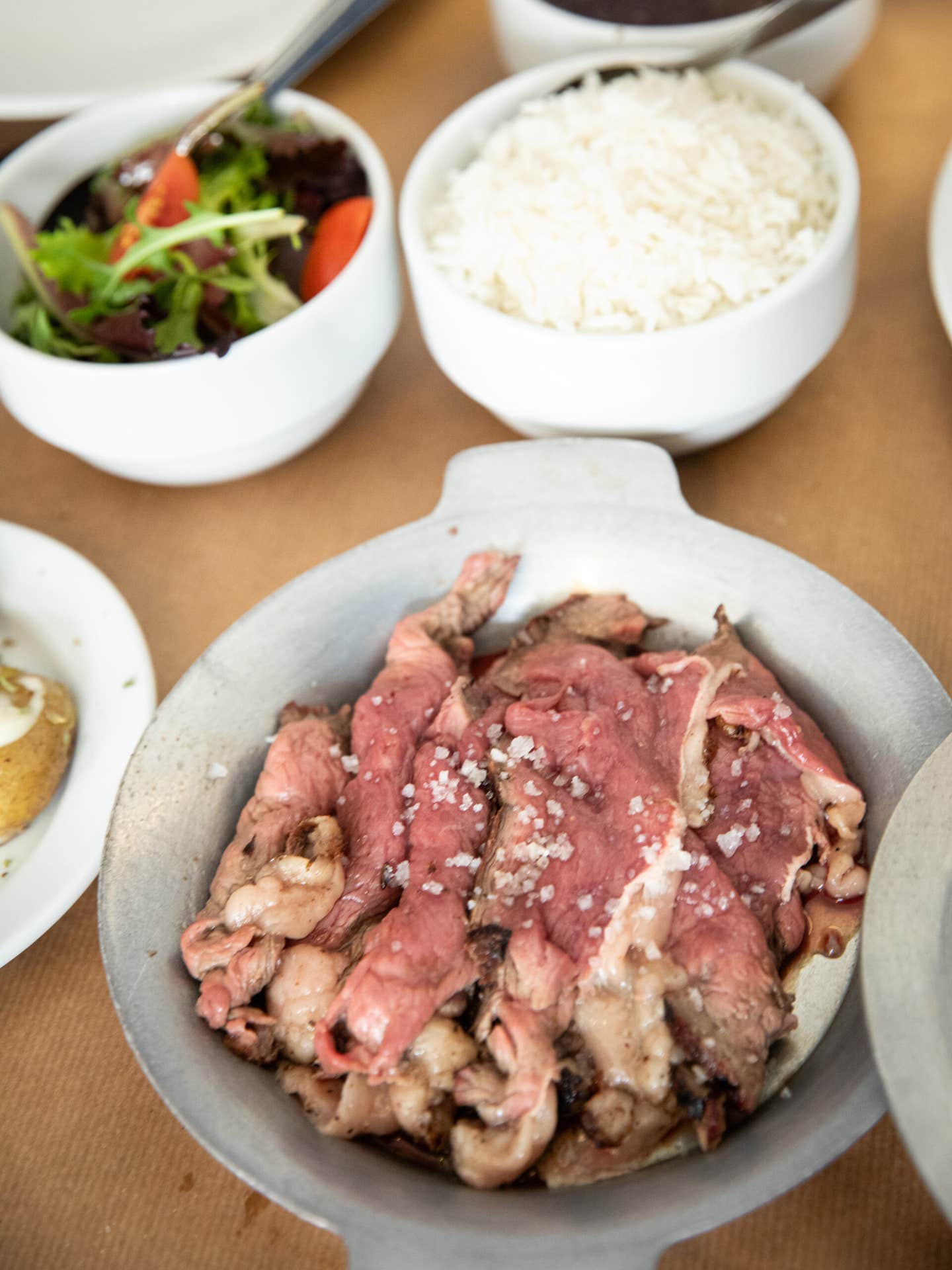
A papal decree in 1494 divided the “New World” between two powers, Spain and Portugal, which is how Brazil became the only Portuguese-speaking nation in South America. Brazil gained its independence in 1822, but its cultural ties to the European nation remain strong (if fraught). Today, an estimated 250,000 Brazillians live in Portugal, and their presence is palpable, especially in Lisbon.
Among the city’s many Brazilian imports are churrascarias, temples of grilled meat. When I lived in Lisbon, Picanha, on a quiet street between Lapa and Santos, gave me my fix. The restaurant is named after the picanha cut, from the upper portion of the rump, which is considered the best in Brazil for its marbling and tenderness. After being roasted on a large spit, it is shaved onto plates in thin, rosy slices. The meat is your reason for coming here, but the black beans are good too. If you’re like me, you’ll want to wash it all down with a sugary, limey caipirinha.
Bebinca at Cantinho Da Paz
Rua da Paz 4,
+351 96 501 4667
When I lived in Lisbon, I’d visit O Cantinho da Paz for a sweet, heady Goan curry. Then, this past summer, Tomos Parry—a British chef with some of the buzziest restaurants in London—reminded me of a dish I’d once had there upon a waiter’s insistence: bebinca, a striated pudding dense with egg yolks and ghee that eats like a flan crossed with a layer cake. It makes the perfect end to the meal, especially with an espresso.
Pastel de Nata at The Decadente
Rua de São Pedro de Alcântara 81,
+351 91 118 3459
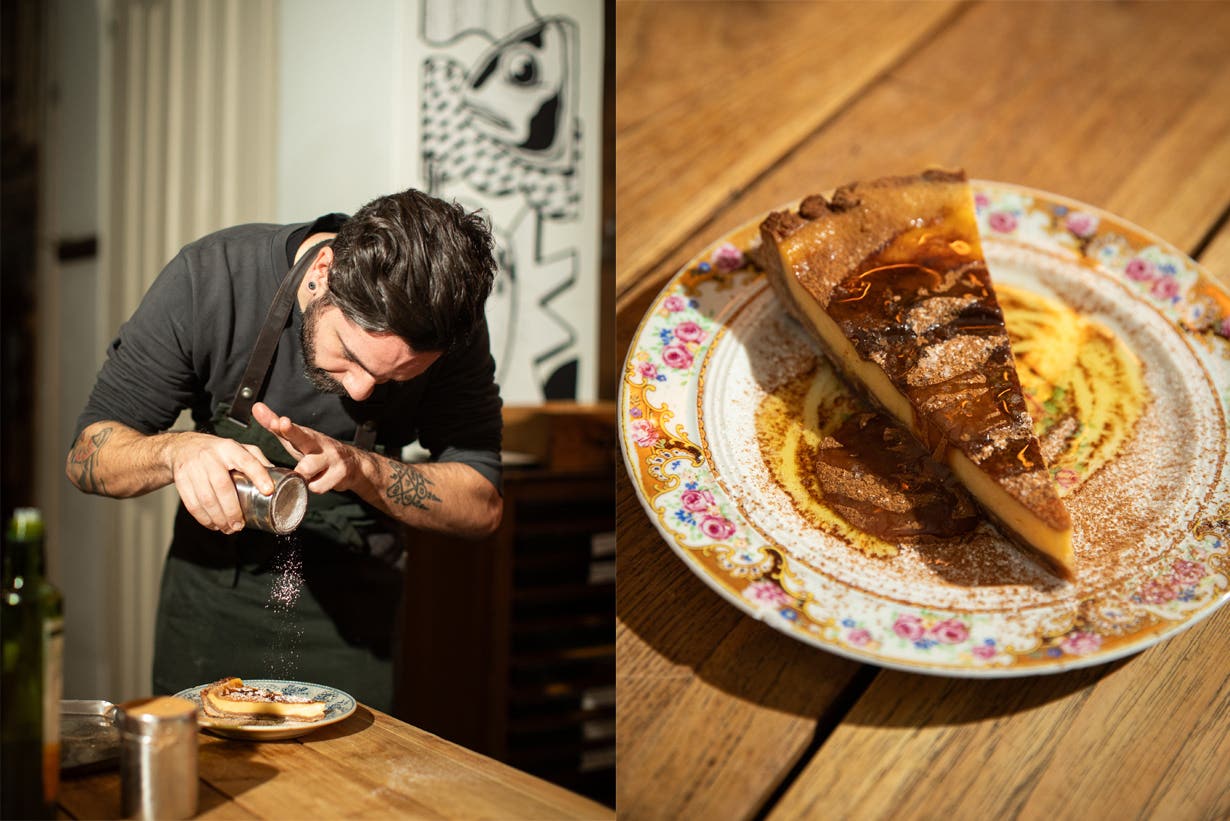
Speaking of eggy desserts, it’s high time we discuss Portugal’s most famous: pastel de nata. Two-inches across and an inch tall, it’s a squat mini-tartelette. The flaky dough is like filo crossed with puff pastry, and the filling is (yes) heavy on the yolks but lightened with milk and cinnamon. Baked until blackened on top—the faint bitterness taming the custard—they are best served warm and dusted with cinnamon.
But the pastel de nata I crave is an unorthodox riff served at The Decadente. It comes by the slice, and the custard is leaner and less saccharine, tasting of milk and cinnamon first, eggs and sugar second. It’s a surprising reinvention that even diehard traditionalists should get behind.
Keep Reading
Continue to Next Story










